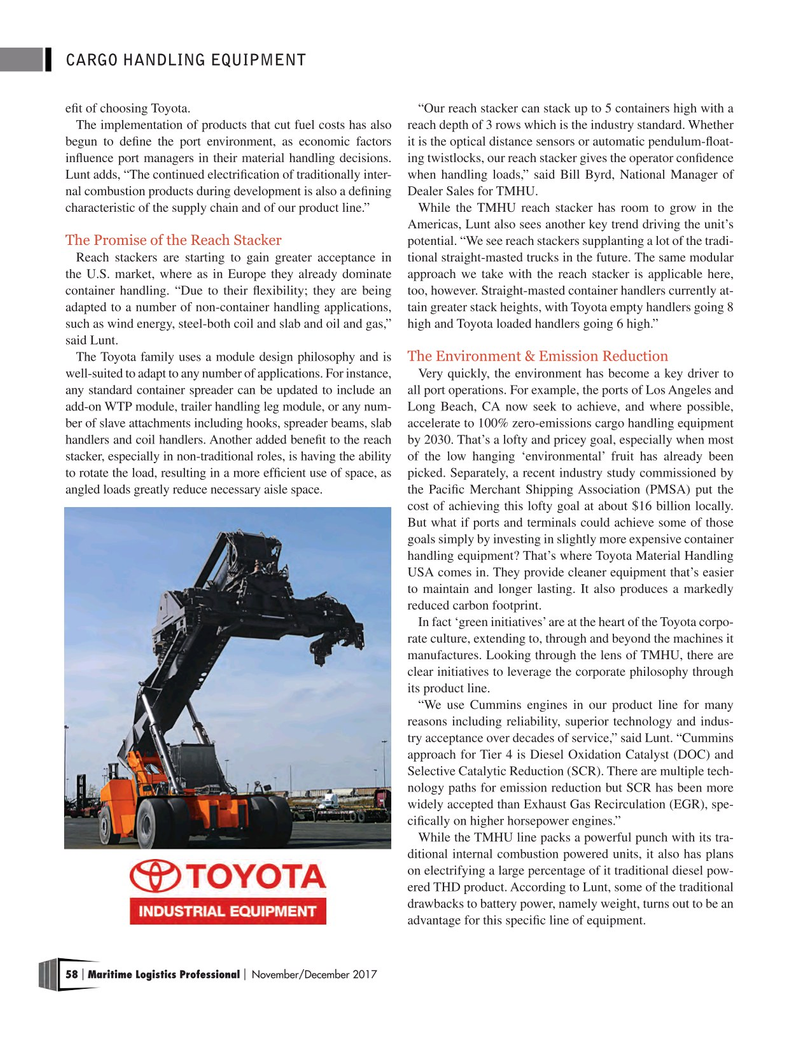
Page 58: of Maritime Logistics Professional Magazine (Nov/Dec 2017)
GREEN PORTS
Read this page in Pdf, Flash or Html5 edition of Nov/Dec 2017 Maritime Logistics Professional Magazine
CARGO HANDLING EQUIPMENT eft of choosing Toyota. “Our reach stacker can stack up to 5 containers high with a
The implementation of products that cut fuel costs has also reach depth of 3 rows which is the industry standard. Whether begun to defne the port environment, as economic factors it is the optical distance sensors or automatic pendulum-foat- infuence port managers in their material handling decisions. ing twistlocks, our reach stacker gives the operator confdence
Lunt adds, “The continued electrifcation of traditionally inter- when handling loads,” said Bill Byrd, National Manager of nal combustion products during development is also a defning Dealer Sales for TMHU.
characteristic of the supply chain and of our product line.” While the TMHU reach stacker has room to grow in the
Americas, Lunt also sees another key trend driving the unit’s
The Promise of the Reach Stacker potential. “We see reach stackers supplanting a lot of the tradi-
Reach stackers are starting to gain greater acceptance in tional straight-masted trucks in the future. The same modular the U.S. market, where as in Europe they already dominate approach we take with the reach stacker is applicable here, container handling. “Due to their fexibility; they are being too, however. Straight-masted container handlers currently at- adapted to a number of non-container handling applications, tain greater stack heights, with Toyota empty handlers going 8 such as wind energy, steel-both coil and slab and oil and gas,” high and Toyota loaded handlers going 6 high.” said Lunt.
The Toyota family uses a module design philosophy and is The Environment & Emission Reduction well-suited to adapt to any number of applications. For instance, Very quickly, the environment has become a key driver to any standard container spreader can be updated to include an all port operations. For example, the ports of Los Angeles and add-on WTP module, trailer handling leg module, or any num- Long Beach, CA now seek to achieve, and where possible, ber of slave attachments including hooks, spreader beams, slab accelerate to 100% zero-emissions cargo handling equipment handlers and coil handlers. Another added beneft to the reach by 2030. That’s a lofty and pricey goal, especially when most stacker, especially in non-traditional roles, is having the ability of the low hanging ‘environmental’ fruit has already been to rotate the load, resulting in a more effcient use of space, as picked. Separately, a recent industry study commissioned by angled loads greatly reduce necessary aisle space. the Pacifc Merchant Shipping Association (PMSA) put the cost of achieving this lofty goal at about $16 billion locally.
But what if ports and terminals could achieve some of those goals simply by investing in slightly more expensive container handling equipment? That’s where Toyota Material Handling
USA comes in. They provide cleaner equipment that’s easier to maintain and longer lasting. It also produces a markedly reduced carbon footprint.
In fact ‘green initiatives’ are at the heart of the Toyota corpo- rate culture, extending to, through and beyond the machines it manufactures. Looking through the lens of TMHU, there are clear initiatives to leverage the corporate philosophy through its product line.
“We use Cummins engines in our product line for many reasons including reliability, superior technology and indus- try acceptance over decades of service,” said Lunt. “Cummins approach for Tier 4 is Diesel Oxidation Catalyst (DOC) and
Selective Catalytic Reduction (SCR). There are multiple tech- nology paths for emission reduction but SCR has been more widely accepted than Exhaust Gas Recirculation (EGR), spe- cifcally on higher horsepower engines.”
While the TMHU line packs a powerful punch with its tra- ditional internal combustion powered units, it also has plans on electrifying a large percentage of it traditional diesel pow- ered THD product. According to Lunt, some of the traditional drawbacks to battery power, namely weight, turns out to be an advantage for this specifc line of equipment.
58 Maritime Logistics Professional November/December 2017 | |

 57
57

 59
59
